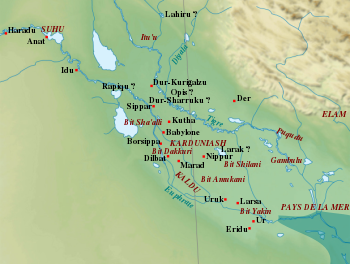Bit-Amukkani

Bit-Amukani(in the Aramaic Assur Ostracon ʾwkn; AssyrianmA-muk-ka-nu;BabyloniandiBit U-ka-a-ni,diU-ka-nu; lit. House of Amukani)was a tribe, proto-state founded byChaldeansin southernMesopotamiawhich stretched from southeast of Nippur to the area ofUruk.[1]It is considered[by whom?]as one of the most powerfulChaldeantribes, next toBīt-IakinandBīt-Dakkūri.
As early as 732. B.C.E. it was ruled by princeUkinzer(also known asMukin-zeriorNabu-mukin-zeri) who became a king ofBabylonin 732. B.C.E. instead ofNabu-shum-ukin IIwhom he superseded.[2]Later,Tiglath-pileser IIIdevastated Bit-Amukani for the second time and defeated Mukin-zeri.[2]Shalmaneser III(856-824) inscriptions note that two Chaldean leaders (Mušallim-Marduk of Bīt-Amukāni and Adīnu of Bīt-Dakkūri) carried silver, gold, tin, bronze, elephant tusks, elephant skins, ebony andsissoowood(or meskannu-wood) as a tribute to the King ofAssyria.
Though unconfirmed statement, the economy of Bīt-Amūkāni probably relied on producing dates.
Tiglath-pileser IIIdescribed his genocide of Bit-Amukani with words: "the land Bit-Amukani I threshed as with a threshing instrument. I took all of its people (and) its property to Assyria." AlthoughTiglath-pileser III's writings testify about conflict with Bīt-Amūkāni, Bīt-Amūkāni never went extinct but actually remained important through laterBabylonianhistory.
Sennacherib's inscriptions note that Bit-Amukani consisted of 39 walled cities and 350 villages.[3]Its capital was Sapia (AssyrianSapīyaorŠapīya).
List of Bīt-Amūkāni leaders
[edit]| Name[4] | Reign | Comments | |
|---|---|---|---|
| Mušallim-Marduk | somewhere during Shalmaneser III | gave tribute to Shalmaneser III in 850 | |
| (Nabû-)mukīn-zēri, king | 731–729 | deposed by Tiglath-pileser III; besieged in Šapīya, but not captured father of Šuma-ukīn | |
| Ea-zēra-(i)qīša | 673 > time of Ashurbanipal | held hostage in Assyria during rebellion of 652–648; his mother was Humbušte (or Humbuštu); assured loyalty of Bit Amukani to Ashurbanipal | |
| ?Kudurru | ca. rebellion of 652–648? | position in tribe uncertain, according to Lipinski governor of Uruk;[5]probably was not Bit-Amukanean, but rather installed by Ashurbanipal |
References
[edit]- ^Zadok, Ran (1985).On West Semites in Babylonia during the Chaldean and Achaemenian Periods: An Onomastic Study.pp. 58–62.
- ^abTadmor, Hayim (2011).The royal inscriptions of Tiglath-pileser III (744-727 BC) and Shalmaneser V (726-722 BC), kings of Assyria.Yamada, Shigeo., Novotny, Jamie R. Winona Lake, Ind.: Eisenbrauns. p. 18.ISBN978-1-57506-657-8.OCLC774282690.
- ^Younger, K. Lawson Jr. (2016).A political history of the Arameans: from their origins to the end of their polities.Atlanta. p. 676.ISBN978-1-58983-128-5.
{{cite book}}:CS1 maint: location missing publisher (link) - ^Frame, Grant."The Political History and Historical Geography of the Aramean, Chaldean, and Arab Tribes in Babylonia in the Neo-Assyrian Period".
{{cite journal}}:Cite journal requires|journal=(help) - ^Lipinski, Edward(31 December 2000).Aramaeans: Ancient History, Culture.Peeters Publishers. p. 435.ISBN978-90-429-0859-8.
